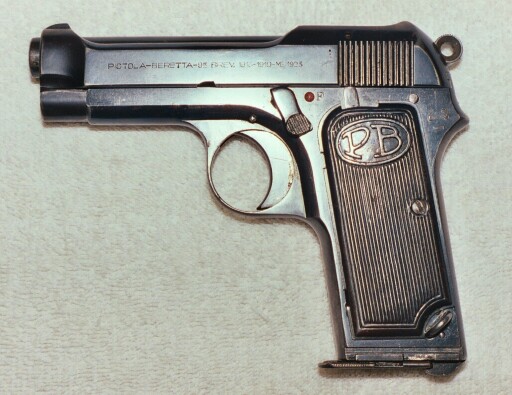The Glisenti
M1910 (top) was the first Italian produced semi auto pistol adopted by
the Italian military. Designed by Bethel Revelli it was originally
chambered for a bottle necked 7.65mm round similar to the Luger round but
with a longer body. Later, it was chambered to use the same cartridge
case as the 9mm Luger but with a reduced loading. The pistol was
manufactured by Siderurgica Glisenti from 1902 to 1907 and from 1908 until
approximately 1925 by Metallurgica Bresciana gia Tempini. Italy officially
adopted it in 1910.
A simplified model
of the Glisenti was developed. It was called the Brixia (bottom).
The machining of the pistol was modified to eliminate several of the steps.
Note from the picture that it is flat sided without the raised areas of
the Glisenti. In addition, the grip safety in the front of the grip
was eliminated.
Both the Glisenti
& the Brixia suffered from a lack of robustness due to the frame design.
The bolt assembly in the receiver is supported only on one side.
When the side plate, which has no structural value, is removed, it is plain
to see that all of the stresses of firing have to be taken up by just one
side rail. This is the reason for the lightly loaded 9mm round.
With Italy in WW1
there was a need for more pistols for the military. Beretta had been
in the gun business in Italy since 1680. Beretta’s Tullio Marengoni
had been working on a semi auto pistol since 1910. This pistol was
adopted as the M1915. It was a straight blow back pistol with no
locking mechanism and used the same low powered 9mm round that the Glisenti
did.
The M1915 is unusual
in the fact that it used 2 manual safeties. One is a slide stop safety
on the left side of the frame. The other is a small lever on the
rear of the frame. If either safety is set, the pistol will not fire.
Also manufactured
by Beretta & adopted by the Italian military was a scaled down version
of this pistol in 7.65mm. In addition to being smaller, it did not
have the manual safety at the rear of the frame.
Both of these pistols
show the characteristic open slide (in this case just at the front) that
became a Beretta trademark.
In 1919 improvements
were made in the 7.65mm M1915 design. The round post barrel mount
where the barrel was lifted straight up out of the frame was replaced with
a T slot mount. This required a larger opening in the top of the slide
so the double opening of the M1915 was changed to a single longer one.
The slide now looked like the open toped style still used by Beretta to
this day. The redesigned pistol is marked on the slide 1915 1919.
The lower photo shows the Royal Navy inspection stamp on the frame.
In 1923 Beretta
introduced a pistol in 9mm Glisenti caliber as a replacement for the military’s
M1915 pistols. It incorporated the M1915/1919 changes plus adding
an external hammer. Some of the M1923 pistols have grooves for a
shoulder stock holster machined into the bottom of the grip frame.
The illustrated pistol is one of these. The shoulder stock holster
was unlike the Mauser in that it was a conventional leather holster with
a hinged folding steel arm riveted to the spine. The end of the arm
had a cut out that slipped over the butt of the pistol & locked in
place. The lower picture shows the stock slot.
In 1930 Beretta
decided to scale down the M1923 & produce it in 7.65mm. This
was basically the same thing that they did with the M1915 pistols.
The scaled down version was designated the M1931. Apparently, only
the Italian Navy bought the M1931. Total production of this model
was about 6,500 pistols. In 1932 the straight rear grip of the M1931
was changed to a curved design. Around 1000 pistols of this M1932 were
produced. Both pistols are rarely encountered.
In 1934 the Italian
government decided to adopt a single pistol to replace the 7 existing models
in use. They specified that the new pistol should be in 9mm Corto
or .380 auto as it is known in the US. Beretta added new steel backed
grips to their M1932 pistol, changed the caliber from 7.65mm to 9mm &
submitted it to the government as the M1934. On August 2, 1935, the
War Ministry ordered 150,000 of the new M1934 pistol.
The Italian Navy
& Air Force did not want the 9mm Corto round for their pistols.
They wanted to retain the 7.65mm round that they were using. Consequently,
Beretta supplied them with the same pistol in 7.65mm marked as the M1935.
The 2 M1935 pistols shown were produced for the Italian military (top)
& German military (bottom). The German one is marked only with
the caliber (7.65mm) & a small 4 UT in a circle. The Italian
military pistols are double dated. The year they were produced is
stamped in numbers on the slide with a Roman numeral following the date.
The Roman numeral is the year of the Fascist calendar which started in
1922 with the year 1.
In 1951, Beretta
designed it’s first non experimental locked breech pistol. It was
chambered for the 9mm Luger cartridge. All previous designs had been
blow back. The pistol was designated the M951. Full production
of this pistol, the predecessor of the US Military M9, didn’t begin until
1956. It was adopted by the Italian Army & Navy as well as Egypt,
Israel & Nigeria. The pistol shown is one of the Egyptian contract
ones. The barrel is longer, the magazine release is on the bottom
of the frame & the back strap is straight. All other M951s have
a barrel that extends out of the slide about ¼", have a magazine
release button & a curved back strap.













